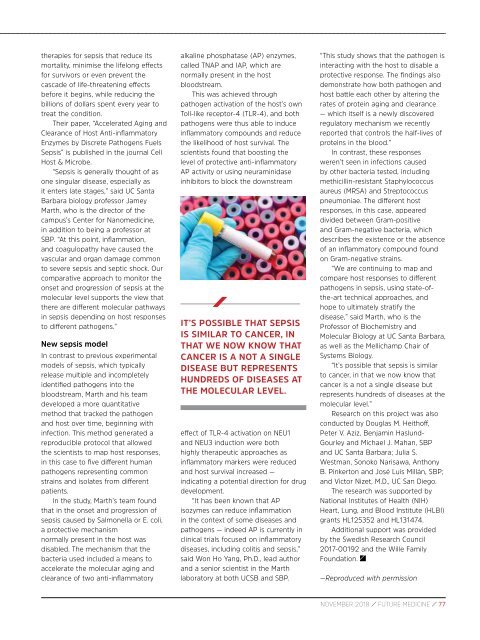Create successful ePaper yourself
Turn your PDF publications into a flip-book with our unique Google optimized e-Paper software.
therapies for sepsis that reduce its<br />
mortality, minimise the lifelong effects<br />
for survivors or even prevent the<br />
cascade of life-threatening effects<br />
before it begins, while reducing the<br />
billions of dollars spent every year to<br />
treat the condition.<br />
Their paper, “Accelerated Aging and<br />
Clearance of Host Anti-inflammatory<br />
Enzymes by Discrete Pathogens Fuels<br />
Sepsis” is published in the journal Cell<br />
Host & Microbe.<br />
“Sepsis is generally thought of as<br />
one singular disease, especially as<br />
it enters late stages,” said UC Santa<br />
Barbara biology professor Jamey<br />
Marth, who is the director of the<br />
campus’s Center for Nanomedicine,<br />
in addition to being a professor at<br />
SBP. “At this point, inflammation,<br />
and coagulopathy have caused the<br />
vascular and organ damage common<br />
to severe sepsis and septic shock. Our<br />
comparative approach to monitor the<br />
onset and progression of sepsis at the<br />
molecular level supports the view that<br />
there are different molecular pathways<br />
in sepsis depending on host responses<br />
to different pathogens.”<br />
New sepsis model<br />
In contrast to previous experimental<br />
models of sepsis, which typically<br />
release multiple and incompletely<br />
identified pathogens into the<br />
bloodstream, Marth and his team<br />
developed a more quantitative<br />
method that tracked the pathogen<br />
and host over time, beginning with<br />
infection. This method generated a<br />
reproducible protocol that allowed<br />
the scientists to map host responses,<br />
in this case to five different human<br />
pathogens representing common<br />
strains and isolates from different<br />
patients.<br />
In the study, Marth’s team found<br />
that in the onset and progression of<br />
sepsis caused by Salmonella or E. coli,<br />
a protective mechanism<br />
normally present in the host was<br />
disabled. The mechanism that the<br />
bacteria used included a means to<br />
accelerate the molecular aging and<br />
clearance of two anti-inflammatory<br />
alkaline phosphatase (AP) enzymes,<br />
called TNAP and IAP, which are<br />
normally present in the host<br />
bloodstream.<br />
This was achieved through<br />
pathogen activation of the host’s own<br />
Toll-like receptor-4 (TLR-4), and both<br />
pathogens were thus able to induce<br />
inflammatory compounds and reduce<br />
the likelihood of host survival. The<br />
scientists found that boosting the<br />
level of protective anti-inflammatory<br />
AP activity or using neuraminidase<br />
inhibitors to block the downstream<br />
IT’S POSSIBLE THAT SEPSIS<br />
IS SIMILAR TO CANCER, IN<br />
THAT WE NOW KNOW THAT<br />
CANCER IS A NOT A SINGLE<br />
DISEASE BUT REPRESENTS<br />
HUNDREDS OF DISEASES AT<br />
THE MOLECULAR LEVEL.<br />
effect of TLR-4 activation on NEU1<br />
and NEU3 induction were both<br />
highly therapeutic approaches as<br />
inflammatory markers were reduced<br />
and host survival increased —<br />
indicating a potential direction for drug<br />
development.<br />
“It has been known that AP<br />
isozymes can reduce inflammation<br />
in the context of some diseases and<br />
pathogens — indeed AP is currently in<br />
clinical trials focused on inflammatory<br />
diseases, including colitis and sepsis,”<br />
said Won Ho Yang, Ph.D., lead author<br />
and a senior scientist in the Marth<br />
laboratory at both UCSB and SBP.<br />
“This study shows that the pathogen is<br />
interacting with the host to disable a<br />
protective response. The findings also<br />
demonstrate how both pathogen and<br />
host battle each other by altering the<br />
rates of protein aging and clearance<br />
— which itself is a newly discovered<br />
regulatory mechanism we recently<br />
reported that controls the half-lives of<br />
proteins in the blood.”<br />
In contrast, these responses<br />
weren’t seen in infections caused<br />
by other bacteria tested, including<br />
methicillin-resistant Staphylococcus<br />
aureus (MRSA) and Streptococcus<br />
pneumoniae. The different host<br />
responses, in this case, appeared<br />
divided between Gram-positive<br />
and Gram-negative bacteria, which<br />
describes the existence or the absence<br />
of an inflammatory compound found<br />
on Gram-negative strains.<br />
“We are continuing to map and<br />
compare host responses to different<br />
pathogens in sepsis, using state-ofthe-art<br />
technical approaches, and<br />
hope to ultimately stratify the<br />
disease,” said Marth, who is the<br />
Professor of Biochemistry and<br />
Molecular Biology at UC Santa Barbara,<br />
as well as the Mellichamp Chair of<br />
Systems Biology.<br />
“It’s possible that sepsis is similar<br />
to cancer, in that we now know that<br />
cancer is a not a single disease but<br />
represents hundreds of diseases at the<br />
molecular level.”<br />
Research on this project was also<br />
conducted by Douglas M. Heithoff,<br />
Peter V. Aziz, Benjamin Haslund-<br />
Gourley and Michael J. Mahan, SBP<br />
and UC Santa Barbara; Julia S.<br />
Westman, Sonoko Narisawa, Anthony<br />
B. Pinkerton and José Luis Millán, SBP;<br />
and Victor Nizet, M.D., UC San Diego.<br />
The research was supported by<br />
National Institutes of Health (NIH)<br />
Heart, Lung, and Blood Institute (HLBI)<br />
grants HL125352 and HL131474.<br />
Additional support was provided<br />
by the Swedish Research Council<br />
2017-00192 and the Wille Family<br />
Foundation.<br />
—Reproduced with permission<br />
<strong>NOVEMBER</strong> <strong>2018</strong> / FUTURE MEDICINE / 77


















